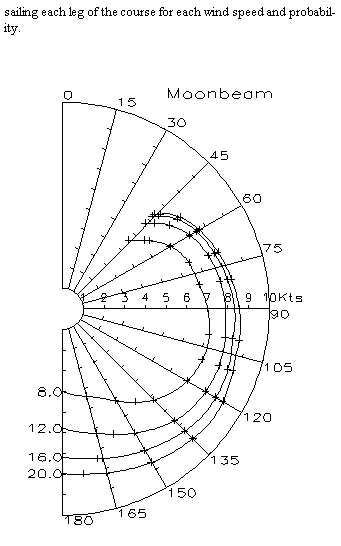| |
This module allows
you to predict the speed of a sailboat
for any wind speed and any point of
sail. It uses the same performance
prediction technique as used by US
Sailing's Lines Processing (LPP) and
Velocity Prediction (VPP) programs.
This performance prediction method (used
for the International Measurement System
(IMS)) is based on MIT Report No. 78-11,
"A Velocity Prediction Program for
Ocean Racing Yachts". Our
module implements both the lines
processing and velocity prediction parts
of this performance model, along with
extensive hydrostatic, stability, and
race analysis tools, as described below.
Hydrostatic
Analysis - Calculates 33
hydrostatic values, such as volume,
center of buoyancy, wetted surface, and
righting moment, for any draft, trim, and
heel, with an optional balance for
trim. It will also print sectional
areas, girths, and centroids. Other
options include conversion between drafts
and freeboards, calculation of vertical
center of gravity (VCG) from a righting
moment, and calculation of draft and
trim, given a displacement and
longitudinal center of gravity (LCG).
Stability
Analysis - Calculates the
following values for heel angles between
0 and 180 degrees (balanced for trim):
draft, trim, righting arm, displacement,
righting moment, area under the righting
arm curve, center of buoyancy, and
distance of rail to waterline. It
also calculates the following overall
values: rail under angle, limit of
positive stability, Capsize Index, Size
Index, Stability Index, positive righting
arm area, negative righting arm area, and
righting arm area ratio. Ballast
tank calculations can also be included.
Body Plan
Output - Displays,
prints, or plots the station definition
body plan for the hull.
Lines
Processing - Uses methods
described in Report No. 78-11 to
determine effective length, beam, and
draft values from the station definition
shape of the boat. These effective
size values are then used by the velocity
prediction section to determine the
performance of the vessel.
Effective size values are used to
eliminate the dependency of the
performance model on a very few point
measurements.
Velocity
Prediction - Calculates the
velocity and heel angle for a sailboat
for any wind speed and course.
Results can be tabulated or plotted in
polar speed diagram form, and many
intermediate and final values can be
printed to evaluate all lift and drag
forces. Another option races the
boat over a predefined or user-defined
course and calculates the total elapsed
time. You can even enter a number
of wind speeds and probabilities so that
the program calculates an elapsed time
which represents
|
|

